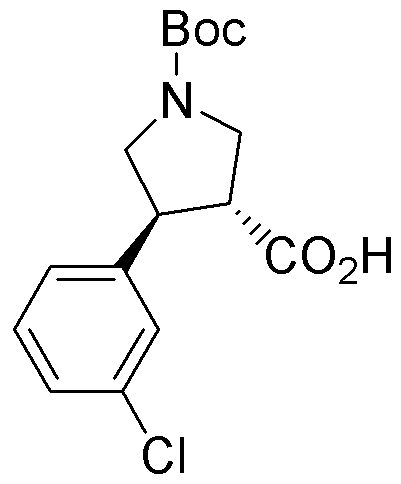Boc-(±)-trans-4-(3-chlorophenyl)pyrrolidine-3-carboxylic acid is widely utilized in research focused on:
- Pharmaceutical Development: This compound serves as a key intermediate in the synthesis of various pharmaceuticals, particularly in the development of drugs targeting neurological disorders.
- Organic Synthesis: It is used in organic synthesis as a building block for creating complex molecules, enabling researchers to explore new chemical entities with potential therapeutic effects.
- Research on Chiral Compounds: The compound is valuable in studies involving chiral molecules, allowing scientists to investigate the effects of stereochemistry on biological activity.
- Drug Formulation: It plays a role in formulating drugs with improved bioavailability and stability, enhancing the efficacy of active pharmaceutical ingredients.
- Material Science: This chemical is also explored in the development of advanced materials, such as polymers, due to its unique structural properties that can influence material characteristics.
General Information
Properties
Safety and Regulations
Applications
Boc-(±)-trans-4-(3-chlorophenyl)pyrrolidine-3-carboxylic acid is widely utilized in research focused on:
- Pharmaceutical Development: This compound serves as a key intermediate in the synthesis of various pharmaceuticals, particularly in the development of drugs targeting neurological disorders.
- Organic Synthesis: It is used in organic synthesis as a building block for creating complex molecules, enabling researchers to explore new chemical entities with potential therapeutic effects.
- Research on Chiral Compounds: The compound is valuable in studies involving chiral molecules, allowing scientists to investigate the effects of stereochemistry on biological activity.
- Drug Formulation: It plays a role in formulating drugs with improved bioavailability and stability, enhancing the efficacy of active pharmaceutical ingredients.
- Material Science: This chemical is also explored in the development of advanced materials, such as polymers, due to its unique structural properties that can influence material characteristics.
Documents
Safety Data Sheets (SDS)
The SDS provides comprehensive safety information on handling, storage, and disposal of the product.
Product Specification (PS)
The PS provides a comprehensive breakdown of the product’s properties, including chemical composition, physical state, purity, and storage requirements. It also details acceptable quality ranges and the product's intended applications.
Certificates of Analysis (COA)
Search for Certificates of Analysis (COA) by entering the products Lot Number. Lot and Batch Numbers can be found on a product’s label following the words ‘Lot’ or ‘Batch’.
*Catalog Number
*Lot Number
Certificates Of Origin (COO)
This COO confirms the country where the product was manufactured, and also details the materials and components used in it and whether it is derived from natural, synthetic, or other specific sources. This certificate may be required for customs, trade, and regulatory compliance.
*Catalog Number
*Lot Number
Safety Data Sheets (SDS)
The SDS provides comprehensive safety information on handling, storage, and disposal of the product.
DownloadProduct Specification (PS)
The PS provides a comprehensive breakdown of the product’s properties, including chemical composition, physical state, purity, and storage requirements. It also details acceptable quality ranges and the product's intended applications.
DownloadCertificates of Analysis (COA)
Search for Certificates of Analysis (COA) by entering the products Lot Number. Lot and Batch Numbers can be found on a product’s label following the words ‘Lot’ or ‘Batch’.
*Catalog Number
*Lot Number
Certificates Of Origin (COO)
This COO confirms the country where the product was manufactured, and also details the materials and components used in it and whether it is derived from natural, synthetic, or other specific sources. This certificate may be required for customs, trade, and regulatory compliance.


